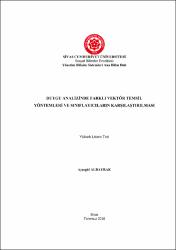| dc.contributor.advisor | Kaynar, Oğuz | |
| dc.contributor.author | Albayrak, Ayşegül | |
| dc.date.accessioned | 2020-01-08T13:22:19Z | |
| dc.date.available | 2020-01-08T13:22:19Z | |
| dc.date.issued | 2018 | tr |
| dc.date.submitted | 2018-07-23 | |
| dc.identifier.other | XI, 73 sayfa | |
| dc.identifier.uri | https://hdl.handle.net/20.500.12418/12071 | |
| dc.description.abstract | Son yıllarda bilişim teknolojileri hayatımıza hızlı bir şekilde girmiştir ve hayatımızı dijital cihazlar veya internet olmadan hayal etmek imkânsız hale gelmiştir. Bugün bloglar, yorum siteleri, sosyal medya platformları sadece kullanıcılara bilgi yayan bir kaynak değil aynı zamanda kullanıcıların birbirleriyle iletişim kurmalarını ve görüşlerini paylaştıkları ortamlar haline gelmişlerdir. Bu tür verilerin bir kısmı öznel olmasına karşın analiz ve karar desteği gibi çeşitli amaçlar için analiz edilebilir bilgiler içermektedir. Bu tür verileri kullanabilmek ve bu verileri işlemek için duygu analizi olarak da adlandırılan bir araştırma alanı ortaya çıkmıştır.
Duygu Analizi, bir metnin otomatik olarak sınıflandırılmasıyla bir konuşmacının veya bir yazarın belirli bir konuyla ilgili tutumunu(pozitif, negatif) belirlemeyi amaçlamaktadır. Etkin sınıflandırma sağlamak için etkili metin temsillerinin oluşturulması çok önemlidir. Bu nedenle tezin ana amacı duygu tahmininde uygulanabilecek yöntem ve teknikleri araştırmaktır. Tez kapsamında iki farklı dilde yazılmış iki veri seti kullanılarak uygulama gerçekleştirilmiştir. Farklı metin temsilleri oluşturma tekniklerinin ve farklı dillerde yazılmış metinlerin duygu sınıflamasında ki etkileri üzerinde çeşitli analizler gerçekleştirilmiştir. | tr |
| dc.description.abstract | In recent years, information technology has quickly entered our lives and it has became impossible to imagine our life without digital devices or the internet. Today, blogs, review sites, social media platforms are not only a source of information for users but also a place where users communicate with each other and share their opinions. While some of these of data are subjective, they contain analytical information for various purposes such as analysis and decision support. A research area has emerged which is named sentiment analysis in order to be able to use and process such data.
The sentiment analysis purposes to determine the attitude (positive, negative) of a speaker or an author on a particular topic by automatically classifying a text. Creating effective text representations is very important to provide effective classification. Fort his reason, the main purpose of the thesis is to investigate the techniques that can be applied to sentiment prediction. In the scope of the thesis the implementation was carried out by using two data sets written on two different language. Various analyzes have been carried out on the effects of different text representation techniques and texts written in different languages on sentiment classification. | tr |
| dc.language.iso | tur | tr |
| dc.publisher | Sivas Cumhuriyet Üniversitesi - Sosyal Bilimler Enstitüsü | tr |
| dc.rights | info:eu-repo/semantics/openAccess | tr |
| dc.subject | Duygu Analizi | tr |
| dc.subject | Makine Öğrenimi | tr |
| dc.subject | Sınıflandırma | tr |
| dc.subject | Kelime Çantası | tr |
| dc.subject | N-gram | tr |
| dc.subject | Word2vec | tr |
| dc.title | Duygu Analizinde Farklı Vektör Temsil Yöntemleri ve Sınıflayıcıların Karşılaştırılması | tr |
| dc.type | masterThesis | tr |
| dc.contributor.department | Sosyal Bilimler Enstitüsü | tr |
| dc.relation.publicationcategory | Tez | tr |















